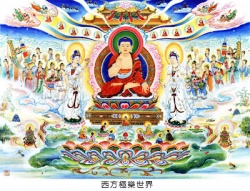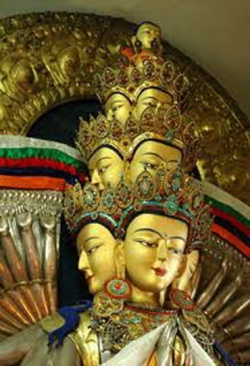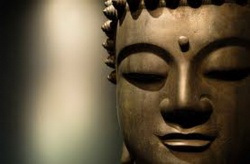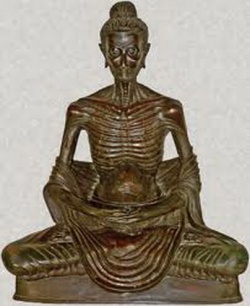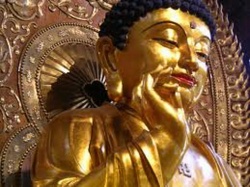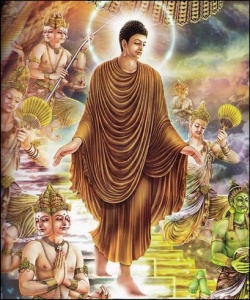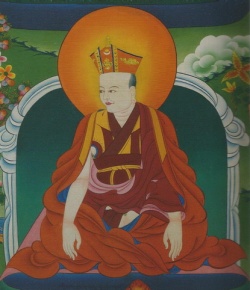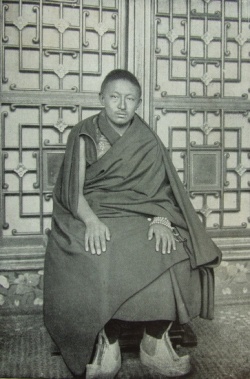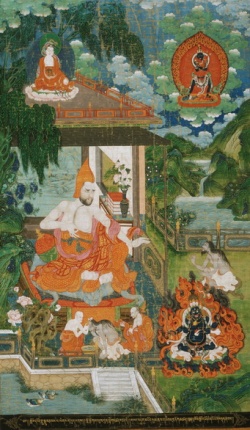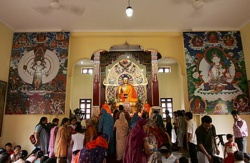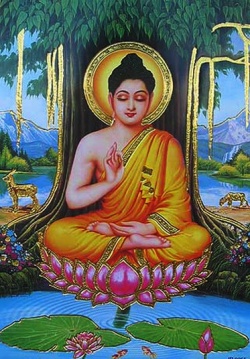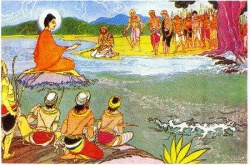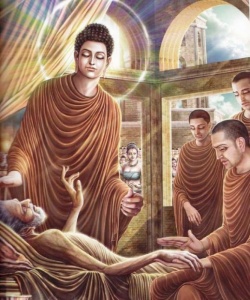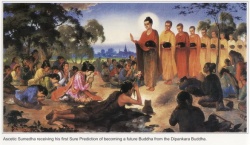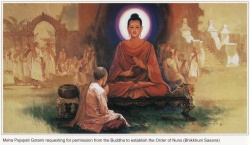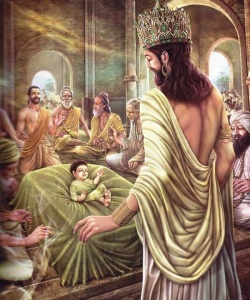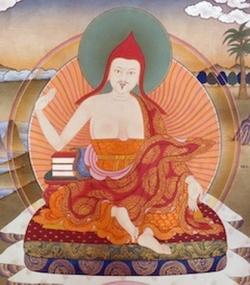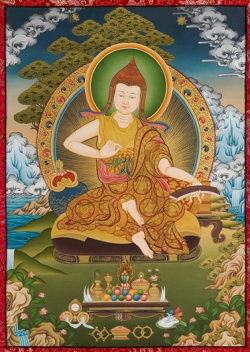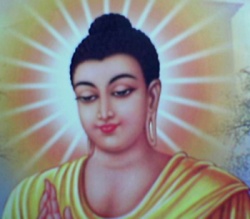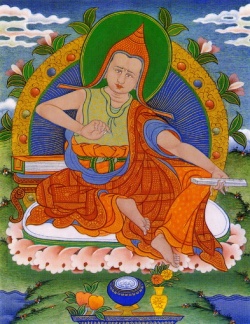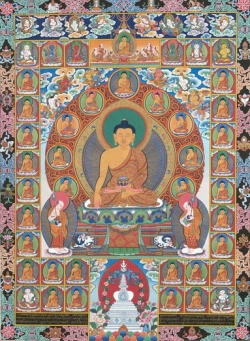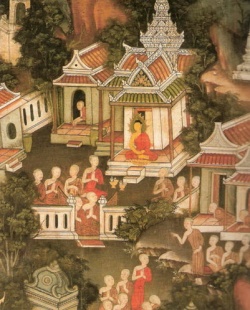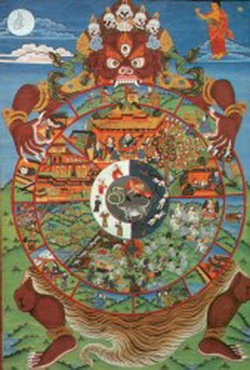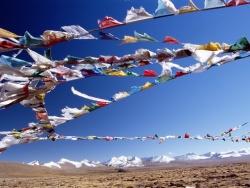Tantric Buddhism and Vajrayana
Buddhist tantra. The expressions Tantric Buddhism and Vajrayana are not exactly synonymous, but they are often used interchangeably. The kind of Buddhism that is most often associated with the Vajrayana is Tibetan Buddhism. That is because Vajarayana plays an important role in it. People can make progress by relying on the written word, ie. teachings that come to us through scripture ("sutra,") and/or they can rely on direct methods that have proven successful and so have been passed from teacher to student, sometimes over centuries ("tantra.") Both play important roles in traditional Buddhism and Himalayan Buddhism is no different in this regard. Mingyur Dorje Rinpoche explains the distinction between the two methods by giving the traditional example illustrative of the difference between sutra and tantra: Let's say there is a person walking along carrying some stones. He sees a dog, and throws his stones at the dog. He also sees a lion and he throws his stones at the lion, too. What does the dog do? At the sight of the stone, the dog immediately tries to bite or chase it.
Then the person gets to throw another stone at the dog. The dog again tries to follow the new stone and bite it. Now this guy has got a big collection of stones, so they are not going to run out any time soon. The dog becomes very tired. Now when the man throws a stone at the lion, the lion does not look at the stone. Rather, he thinks, "Where did that stone come from? Who threw that stone?" When he sees the person who threw it, he pounces on him. A person only gets to throw one stone at a lion. Origins of the Vajrayana The historical Buddha, more than 2500 years ago, addressed the objective of Enlightenment from four different perspectives. He is held to have used many different approaches and techniques to do so in order to help all types of sentient beings. Tradition says that he taught 84, 000 different ways, but that not all of those were given by his "ordinary" self.
The bodhisattva who was to emanate as Prince Siddhartha Gautama, and who eventually would be Buddha Shakyamuni, had attained the Tenth Bhumi without any Vajrayana practices. While dwelling in the Akanistha Realm in a state of deep samadhi, he was snapped out of that state by the Tathagatas of the ten directions and three times, who all gathered together to say "This samadhi of yours is not sufficient for attainment of Bodhi!" So, having invited the Devis to participate, the Buddhas bestowed upon the bodhisattva the last two of Four Empowerments. On engaging in the practices related to these empowerments, the final objective was attained. In His example, we understand that Buddhahood cannot be attained without going through the Vajrayana or Resultant Path. Furthermore, it is possible for someone to complete the Causal Path of Shravakayana and Paramitayana, which in this case took more than three aeons, and then to enter the Resultant Path for that final segment of the Way. We should understand, though, that Lord Buddha was actually a complete and perfect buddha before his appearance in this world as Prince Siddhartha.
It is only due to His prior aspiration and the need to set an example for sentient beings whose karma had ripened sufficiently for them to be born in this Good Aeon, that He: appeared to be born, get married, have a child, leave home, practiced asceticism, renounce wrong paths and attained Enlightenment after subduing the Maras. After that, He turned the Dharmachakra three times and, having taught and lived for 80 years, He eventually passed beyond existence (Skt. parinirvana,) in order to teach the lesson of Impermanence. It is clear that this achievement was not a case of "self-empowerment" and an invention of [the] Vajrayana.
He was a Hindu practitioner until the time of his bodhi. He unequivocally pointed out the flaws of those spiritual traditions then. Many of those ideas are mirrored in some spiritual cocktails currently being concocted. ~ edited for this page from a contribution by BB to the Kagyu email list, June 2002. Since Buddhism faded from India, authentic Vajrayana teachings owe their existence today to translators such as Marpa (11th century) who undertook a number of arduous journeys from the Tibetan plateau periodically to retrieve them. The texts and methods that were being preserved in the monasteries of Tibet until the mid- twentieth century, are now being collected and preserved by us.
The mechanics of Tibetan Buddhist tantric practices. < Lynne Haekert Vajrayana (the thunderbolt vehicle) is the Buddhist system that incorporating tantric methods. It means that exercises, practices and rituals are handed down directly from teacher to student by word of mouth, though often with the aid of teaching materials in the form of pamphlets and pictures. Even though Buddha Shakyamuni rejected the notion of a permanent Self, he acknowledged the belief in rebirth. He said that this was not inevitable and he taught the methods that he, himself, had used to achieve enlightenment and release from the bonds of the wheel of rebirth (Skt. sangsara or samsara) in a single lifetime.
Vajrayana works to transmute one's "imperfections" and ordinary awareness by means of un-ordinary and also, some extraordinary methods. For example, the system of chakras and nadis that some people know about from other contexts are also utilized in this system, where it is often called "working with the winds and drops." An advanced initiated student with an agreeable partner or consort can receive instruction in working with this energy as a couple. It must be stressed that the primary objective is not enhancement of physical sensation. The Guru Every Buddhist takes refuge regularly in the Three Jewels: Buddha, Dharma, Sangha.
The Vajrayanist adds three others of which the first and foremost is the guru. That is because without a mentor or lama, access to any of the special methods would not be possible. We have seen (The Meaning of Tantra) that even to begin the so- called preliminaries, it is not sufficient to have read about them.. Ashvaghosha's 50 Verses on Guru Devotion (Gurupanchasika, commentary by Geshe Ngawang Dhargey.) Kinds of Guru Tibetans say that each lama has his or her way of teaching. This is an ancient idea deriving from Indian tradition holding that there are various types of guru (Tib. lama.) They range from "vidya gurus," teaching through knowledge of scripture, to charismatic or "diksha gurus," who directly transmit realization.
Creation and Completion One of the main techniques used of any tantric practice is the use of the imagination. That is, we imagine in great detail, using the "mind's eye." There are usually two or three parts to a tantric practice: the visualization of the deity, the visualization of the self as deity, and then the dissolution or resolution of the visualization into Emptiness. For example, one imagines the form, colors, clothes, and ornaments of Chenrezi not as a material body, but as a translucent form similar to that of a rainbow, or a virtual image like the moon in water. In the same way, the mantras, or speech element are understood as the union of sound and emptiness.
Finally, the mental activity - - the imagination and the thought -- is understood as empty Tantric "creation" uses techniques that work with body, speech and mind in new ways involving the insubstantial union of appearance and emptiness. "Completion' is the result of this play, after which awareness rests in the union of intelligence and emptiness to various degrees. Creation and Completion: Essential Points of Tantric Meditation by Jamgon Kongtrul is the recommended text on the process. Ven. Thrangu Rinpoche on Generating the Deity Samaya As it is said: Tantric Buddhists are in the position of a snake inside a bamboo tube; one hole faces up to the Dharmakaya, the other down toward Vajra Hell.
There are only two options -- up or down; no in-between. Keeping samaya (commitment) determines which way the snake slides. In Tibetan Buddhism, it is generally held that the paths of the Hinayana, Mahayana, Vajrayana are a progression. "There is an analogy concerning three pots: the "hinayana" vows are like a clay pot--you drop it once, it's broken ... gotta get a new pot! The Bodhisattva vows are like a brass pot -- drop it, and it'll take some work to hammer out the dents, but it's fixable, with some elbow grease and sweat ... and maybe you may have to take it back to a "licensed pot-mender!" The Vajrayana vows are like a pure gold pitcher.
Since this type of pot is made of the softest metal, it is the one most susceptible to dents! [It must be handled very carefully. ] Realistically, for those who have truly received the Highest vows, they are all constantly breaking them ... Well, maybe most of them, at least. These Anuttarayoga vows are really only properly attempted in a closed retreat, I would say -- at least until one has achieved a solid experience in maintaining divine pride. ... . Of course, for those who wish to dispense with all vows, there's the invisible pot of the Mahamudra and/or Dzokchen ... no pitcher to even worry about! Find your water at the source ... ." ~ CB, the Kagyu email list, who adds, "May we keep whatever vows are appropriate to us."
For those that embark upon the Vajra path, there are 14 precepts to observe. The 14 Vajrayana Precepts We are considered to have broken our samaya or tantric commitments if we 1. Show disrespect for the Guru in body, speech, or mind 2. Having no regard for the rules laid down by the Buddha 3. Condemn and/or create problems with one's Vajra brothers and sisters 4. Abandon love for sentient beings 5. Relinquish Bodhicitta due to difficulties 6. Slander the scriptures of Mahayana and Vajrayana 7. Transmit tantric teaching without having the proper empowerment and credentials 8. Abuse and/or foster attachment to the five skandhas, ie. world of appearances 9. Harbor skepticism or doubt about the doctrine of Emptiness 10. Maintain ties to beings with cruel intentions towards Buddha and his teachings 11. Indulge in accomplishments forgetting the purpose of Vajrayana practice
12. Fail to transmit authentic Dharma 13. Fail in performance of tantric ritual practices 14. Despise/or condemn Women Even accomplished masters sometimes have problems keeping their vows. Jonang Taranatha, one of the greatest saints and historians of Tibetan Buddhism, told (The Seven Instruction Lineages) how Vajrayogini appeared to about one of his spiritual grandfathers, Abhayakaragupta, three times in his life: once when he was a Tirthika (Hindu practitioner,) once when he was a Buddhist monk, and finally after he had become an accomplished Tantrika. Each time she offered something for him to do or to eat. Three times he refused, thus breaking one or more of the Tantric vows and precepts. After each time someone was kind enough to let him know what had happened, but it was not until the third time that he realized his mistake. He confessed his error to Vajrayogini, who appeared to him once again and said, "In your manifold births you have intoned mantras to me and made me offerings. Although I have offered you siddhi (accomplishments, powers) on three occasions, you have not accepted it.
You will not attain the highest siddhi in this life. You must write many shastras, preach dharma to many people and then, in the after-death state you will attain perfect siddhi." BB comments: "Somewhat happy ending, right? Well, sometimes not as so -- it is said that breakage of the 14 and the 8, if not confessed or mended, buys one a ticket on the express to Vajra Hell. One may not always get all those chances like Abhayakaragupta did. Having said all that, if even accomplished masters are vulnerable, I guess I would not feel too bad about breaking a couple of these vows and precepts -- I should however be more diligent in applying those restorations and antidotes.
To really maintain these vows, which means either not breaking them in the first place or applying the restoration within the proper time-frame, one really has to almost be in a closed retreat situation ... . Divine pride must be maintained every second. The Vajrasattva or Samayasattva Purification has to be done a set number of time each day. Sadhana practices involving empowerment must be done daily if one is doing mainly the Kye Rim; self-initiation must be done daily if Dzog Rim. One must be mindful and re-exam oneself every session of the day to ensure everything is all right or mended. In our everyday life, that's close to impossible. But Vajrayana is not supposed to be a safe and cozy path anyway; any attempt to hang it out as something as peaceful and comfortable (like the Shravakayana and, to a lesser degree, Paramitayana) is doing nobody a favour. A correct understanding of its gravity and rigor would enable one to: 1.
Make an intelligent decision as to whether to undertake it -- remember that Vajrayana is not the only game in town; 2. Not be influenced by charlatans and fake Vajrayana "masters" who spin a whole lot more out of "Samaya" and use it to abuse and exploit; and 3. Strive and make real progress on the Path, instead of cheating oneself with the false-comfort that all vows are intact and one is on the express to Bhumi-land. See, we are not all right -- otherwise we would not be here in Samsara -- but it is all right to be not all right. We just need to work at it harder. ~ BB, to the Kagyu email list Classification of Buddhist Tantras Traleg Kyabgon Rinpoche's Essence of Buddhism includes Levels of Tantra (138) from a Kagyu point of view: Levels of Tantra Vajrayana practices, or tantric teachings, have been systematized into four categories, and practitioners are encouraged to follow them in a systematic and gradual way.
The relationship that exists between the visualized deities and the practitioner will go through different transitions, depending upon the level of Tantra with which the person engages. Even the natures of the visualized deities are different; they may be wrathful or peaceful, for example. Kriya Tantra The first level of Tantra is Kriya Tantra, or bya gyü in Tibetan. Kriya emphasizes the performance of rituals. Three different Buddha families are mentioned at the Kriya tantric level: the Padma, or Lotus family; the Vajra family; and the Tathagathas or family of the Buddhas. At this level, the relationship between practitioner and deity is essentially unequal.
We see ourselves as being deluded, while the deity is worshipped as having all the power to impart wisdom. Charya Tantra The next stage is Charya Tantra, or chö gyu. Charya emphasizes the importance of both meditative states and ritual observances. At that level, there is no longer the same sense of inequality as with Kriya Tantra. The deities are seen as friends more than exalted beings, even while having little in common with the practitioner in terms of qualities. At that Charya level, deities are visualized as having two aspects, relative and absolute.
The absolute nature of visualized deities is understood to be no different from one's own Buddha-nature, or the nature of Mind. The basic point is that the visualizations are not absolute since they are understood as projections of the mind. Anuyoga Tantra The next level is Anuyoga Tantra, or jesu naljor gyü. Here one relies less and less on relative truth and aims towards absolute truth. At the Anuyoga level, it is said that one must have developed bodhichitta and taken the Bodhisattva vow, for without it one cannot continue the practice. Anuyoga deals with delusions and defilements directly, so that they can be transformed into the Five Wisdoms. When understood properly, these very delusions can be transformed into wisdom, and therefore the delusions are the very material that constitutes what is meant by wisdom.
There is no sharp distinction between what should be abandoned and what should be cultivated at this stage. If one knows how to deal with things that normally give rise to delusions, one can gain insight and wisdom instead Supreme Yoga Tantra: Becoming a Total Person The final level of Tantra is Mah'anuttarayoga Tantra, or la-me chenpo'i gyü, is considered to be the supreme level. It is also the most difficult one to practice. Unlike the other Tantras, on this level the practitioner deals directly with his or her conflicting emotions through practices such as the visualization of wrathful deities.
Systems of Classification Je Tsongkhapa wrote extensively about the issue of the several ways of classifying the tantras in his Ngakrim Chenmo and some other important works. He showed that there is not only one system, but many, and none is necessarily better than another. Amongst contemporary teachers and writers, Vidyadhara Chogyam Trungpa dealt with the topic several times, in books such as Journey Without a Goal and The Lion's Roar. The Nyingma denominations organizes the tantras into 6 levels (3 Outer and 3 Inner) based on the level of accomplishment and the view of Emptiness/awareness.
In the Kagyu tradition, the way the Outer Tantras are classed and labeled is not much different from that of the Nyingma; for the Inner Tantras, the differences are more pronounced. To begin with, the Tantras referred to by Nyingmapa as Inner Tantras are not even the same as those included in the Kagyupa's Anuttarayoga Tantra, a label that adds to the confusion since the Nyingma use it to refer to their Inner Tantras. This is only natural, for the collections came to Tibet in two separate periods of translation.
The Anuttarayoga Tantras include the five major ones: Guhyasamaja (Secret Gathering), Yamantaka (Death Conqueror), Hevajra (Hail, Vajra!), Mahamaya (Great Play of Illusion) and Chakrasamsavra (Wheel of Great Bliss.) The now famous Kalachakra Tantra (Wheel of Time) was apparently a later addition, but is in no way inferior to the others." The second difference lies in the way the classification is done. Unlike [method of classification of] the Nyingmapas, the further sub-division of the Anuttarayoga Tantras is not based on view or accomplishment; instead it is based on the object and method.
Since we are troubled by the Three Poisons [kleshas] of Ignorance, Passion and Aggression, and since the Tantras are to help us "get over" them, certain Tantras were taught and developed to focus more on one Poison versus another. However, it should be pointed out that it is all a matter of emphasis -- ultimately, it does not mean that a Tantra is somehow "lacking" in any particular way. Anuttarayoga Tantras are classified as either Mother, Father or Non-dual Father Tantra [comprises]: Anuttarayoga Tantra practices utilizing mainly aggression as the path, focusing on the emptiness aspect of Buddhanature.
Examples of Father Tantras include Guhyasamaja and Yamantanka, as well as the practices of "illusory body" and of dream yoga. Mother Tantra: Anuttarayoga Tantra which utilize desire as the path, focus on the luminosity of Buddha- nature. Examples include Chakrasamvara, tummo [heat/energy generation], and clear light yoga. Non-dual Tantra: Anuttarayoga Tantra practices utilizing equally, desire and anger, act as an antidote to the 3rd poison which is ignorance. They place equal focus on the luminosity and emptiness aspects of Buddha-nature. Examples include Kalachakra, Hevajra and the yoga of the Bardo.
So, for example, if you are a person with a short fuse, who gets angry all the time, it is sometimes beneficial to take advantage of that "natural" propensity by pursuing the Father Tantras. Then, in some of the illusory body practices, ... , you don't have to exert yourself too much to gain accomplishments. When it gets to the top [advanced tantras] however, there is little if any difference between taking the aggression path versus taking the passion path -- it is all the same: non-duality of luminosity and emptiness.
Also, different traditions interpret and classify the Tantras differently. For example, Je Rinpoche puts Hevajra under "Mother " instead of "Non-dual." Furthermore, the labels used for these practices may be different, e.g., in Dzogrim practices, the Guhyasamaja mentions Speech Isolation, Body Isolation, and so on, instead of 'Six Dharmas.' While the Kagyu Lineages are especially adept at Chakrasamvara, they also maintain lineages of Guhyasamaja, Hevajra and Kalachakra Tantras. Whether they have Mahamaya and Yamantaka, I am not sure.
One last point about the Nyingma/Kagyu difference is that the Nyingma also talk about Father, Mother and Non-dual Tantras, using them to refer to the three yogas within the Inner Tantras -- Father for Maha-, Mother for Anu- and Non-Dual for Ati-. [For us, this may be] Kind of confusing, but they have their valid points there too." ~ edited from contributions to the Kagyu email list by RM , BBW, and others.
Requirements Kyabje Kalu Rinpoche, who served for many years as the Chief of Meditation of the Kagyu denomination explained, in his Gently Whispered (New York: Station Hill, 1994): "Most tantrayana or vajrarana visualization and mantra practices require that an initiation and subsequent authorization and instruction be given by a qualified lama before the sadhana, or ritual practice, can begin.
However, a few practices, those that were given publicly by Lord Buddha Shakyamuni, do not fall under such restrictions. Very definitely, all the practices given in the Sutras have the full blessing of the Buddha and therefore can be practiced if one has the aspiration to do so. Such practices include those of the noble Chenrezig and of the mother of the buddhas, Green Tara. Naturally, whenever it is possible for you to take the vajrayana initiation of Chenrezig or Green Tara, you are encouraged to do so.
Right now, however, the practice in which I am giving you instruction can be practiced straight away, due wholly to the blessing of Buddha Shakyamuni. When you finally do get around to receiving the Chenrezig initiation, it will deepen your practice and strengthen your connection with your tsaway [root] lama and with Yidam Chenrezig." The book, whose title appears at the start of this quotation, has a complete sadhana of Chenrezi. Obligations Samaya is the bond, commitment or duty that is the consequence of any initiation or empowerment. It ties the practitioner to his or her teacher, to the practice and to the tantric deity. There are levels of samaya. In the narrowest sense, it may be the commitment to do the practice regularly, to say a series of mantras or do some other activity . But even in listening to teachings, there is the implicit commitment to apply what has been heard.
Tantric practice and food. A detailed explanation of Empowerment. Note: This is one of two articles about "Tantra." The Meaning of Tantric is a general one that defines and attempts to clarify the word and its associations. It discusses a little about the Hindu tantric tradition, sexual references and shamanism. Akanistha Realm: Akanishta is the highest peak of Existence-as-Form. It is a heaven presided over by Ishvara (Shiva) who is called the Great God, the Auspicious One. It is the heaven of Samantabadhra Buddha. samadhi: a profound state of blissful consciousness that is usually the result of meditative ability. Tathagatas: "Thus Come" or "Ones who are Gone," the Buddhas; they achieved Awakening and so never are reborn or die. Abisheka: consecration, anointing. types of guru: Indian tradition holds that there are 12 kinds:
Japan-buddhist.jpg
A Datuvadi guru imposes austerities and penance via the yoga "of force." The emphasis is on physical exercise, special breathing, generating heat, and so on. The presence of a Chandana Guru emits the odor of sanctity. He is like a sandalwood vine, whose fragrance is shared with some kinds of tree, but not others. That is, such a master is only capable of influencing those people whose nature is receptive.
A Vichara Guru appeals to reason. He is able to dispel doubt through the comprehensive exposition of teachings. The Anugraha Guru can teach solely by means of a glance. He (or she) has the power of transforming the disciple despite the fact that he is not especially learned. The Parasha Guru is like a touchstone. It is only marked when, under the right circumstances, an object of gold comes into contact with it. Base metals leave no trace.
Such a master can also heal by means of contact, although actual touching is not necessarily involved, here. Such a guru is also believed to be vulnerable in a way, since he or she can absorb the ailment of a person whose motivation is not pure. Kashyapa Guru is like the mythological tortoise, capable of feeding its young by a mere glance. This powerful look, or kripa kataksha, inspires the disciple to great accomplishment. A Chandra Guru is like the moon.
It is thought to have a mysterious relationship with the chandrakantha, or moonstone, whose special quality is that it, alone among gems, is believed to have the ability of capturing the moon's rays. In the Indian tradition, the moon has a cooling, soothing influence. A Darpana Guru acts as a mirror. Perfectly transparent and without any blemish, he or she acts to reflect the disciple's own qualities. If the disciple is properly prepared, by monitoring her own nature in this way, the true nature of existence is revealed. A Chayanidhi Guru is like the mythological bird that confers a royal estate on whomever its shadow touches.
Simply the shadow of such a teacher confers blessings. A Nadanidhi Guru is like the Philosophers' Stone that transforms base metal into gold. Through the action of calling upon such a guru, the disciple can be transformed. A Kroncha Pakshi Guru is like the mythological crane, a bird that migrates great distances. It can nourish its young simply by calling them to mind. A Suryakanta Guru is one whose darshan (physical presence, display) acts like a burning glass. That is, just as a lens can focus the sun's rays to burn up a piece of lint, so the mere sight of this kind of guru can consume the disciple's karma. "Various medicines have various types of strength or power. Water has a power to wet things and clean things. Fire has a power to burn. When we put water in a field it helps to grow flowers or crops.
All phenomena have a particular power associated with them. Through the power of interdependence, when we ask for the blessing, blessing comes as a particular type of power. One receives that power, the blessing, and one's defilements and obscurations are purified and dispelled. " ~ Yongey Mingyur Dorje Rinpoche Initiation, Empowerment or wangkur A characteristic feature of Vajrayana Buddhism is the requisite ritual for participating in the worship, service and practice (Skt.: sadhana) of a deity or bodhisattva. This is the process by which a lama with experience in the particular practice confers on others the description, explanation, visualization and order of the practice, along with appropriate offerings and specific mantras. It is more than the sum of its parts though; it is a lineage transmission of blessing and energy.
The empowerment or initiation grants permission, bestows help with, and gives access to, the benefits of a tantric practice. It can be short or long, and complex or very simple. It normally includes the wang (Skt. abisheka) which is the actual consecration or dedication of the student to the practice-deity, the lung which is the oral transmission -- a recitation of the procedural text or manual (sometimes in a condensed or speedily-read version,) and the tri or instructions on how to do the practice.
In special cases, a brief ritual-touching of the student with the text, accompanied by recitation of the associated mantra is sufficient. Kyabje Kalu Rinpoche (d. 1989,) who served for many years as Chief Meditation Master of the Kagyu, in Gently Whispered (New York: Station Hill, 1994) said: "Most tantrayana or vajrarana visualization and mantra practices require that an initiation and subsequent authorization and instruction be given by a qualified lama before the sadhana, or ritual practice, can begin. However, a few practices, those that were given publicly by Lord Buddha Shakyamuni, do not fall under such restrictions.
Very definitely, all the practices given in the Sutras have the full blessing of the Buddha and therefore can be practiced if one has the aspiration to do so. Such practices include those of the noble Chenrezig and of the mother of the buddhas, Green Tara. Naturally, whenever it is possible for you to take the vajrayana initiation of Chenrezig or Green Tara, you are encouraged to do so. Right now, however, the practice in which I am giving you instruction can be practiced straight away, due wholly to the blessing of Buddha Shakyamuni. When you finally do get around to receiving the Chenrezig initiation, it will deepen your practice and strengthen your connection with your tsaway lama and with Yidam Chenrezig." Gently Whispered contains a complete sadhana of Chenrezig which is possible to practice without an empowerment beforehand, although the practitioner should see to getting one as soon as possible. What Will Actually Take Place? A complete Buddhist empowerment is usually divided into four parts:
1. vase empowerment
2. secret empowerment
3. knowledge-wisdom empowerment
4. speech, sound, word or "suchness" empowerment Tom: " . . . the fourth empowerment, although called the "Word Empowerment", is not always given or introduced with "words."
Sometimes an object is displayed that illustrates the clarity and luminosity of mind. I remember receiving one empowerment when the word empowerment was bestowed in a manner that I cannot rightly describe. It may have been a word but if so, it went by so quickly that others who were present didn't even notice it happening. It certainly was a sound, and it was certainly from the lama, but its signification was lost on me, although the shock of hearing such a loud and punctuated sound from one who had previously been quietly chanting was quite remarkable. Perhaps it was this suddenness that prevented others in the group from even hearing it. Hmmmm. " (Initiations for the practices of Chenrezig or Tara do not generally fit that pattern.) Transforming Poison into Nectar Here is an excerpt from Khenchen Konchog Gyaltshen Rinpoche's (as yet, unpublished) commentary on Bhante Dharmaraja's Jewel Treasury of Advice: 100 Verses from the Heart.
The Drikung Kagyu master [whose Sanskrit monastic name is transliterated to respect a regional accent as] Bhande Dharmaradza, lived from 1704 to 1754, and is considered a reincarnation of the great Dharmakirti (1595-1659.) ***** (The Verse) The ripening four empowerments are like a stream of nectar. They purify the four obscurations and plant the seeds of the four kayas; they are the root of the path of mantra. This is my heart's advice. (The Commentary) When we have a qualified lama and have kept the samaya, then we can receive Vajrayana teachings. If you ask for the distinction between the sutra and tantra systems, it is the empowerment ceremony, abhisheka in Sanskrit.
Any practice for which empowerment is required, that is what we call a Vajrayana practice. If a practice does not need an empowerment first, then it is from the sutra system of practice. Many masters have different explanations of this point, but this one from Lord Jigten Sumgön [1143- 1217] is very clear and precise. Our ordinary mind is hard, unripened. So, it must be ripened with the empowerments.
In Tibetan, the word for nectar is dutsi, which means a substance that transforms poison into nectar. It is also called stainless ambrosia or un-afflicted nectar. So the reference here recalls this quality of transformation, like alchemy. In alchemy, base metals are transformed into gold. Our mind is like that base metal, which is transformed into gold by the empowerment ceremony. While the stream of the nectar is poured into us during the ceremony, we meditate that we transform into the deity state, thereby purifying all our negative thoughts and obscurations. We manifest our mind as the deity's mind. Our whole being is transformed into the mandala of the deity. Through the four empowerments we purify the four obscurations. By purifying the four obscurations, we plant the seed to achieve the four kayas the future.
These steps are the basic elements of tantra, the root of the Vajrayana system. Without these ceremonies, we have no authority to practice Vajrayana, so we cherish this so much. The four empowerments are: • vase, • secret, • wisdom, and • fourth. The four obscurations are: • physical, • verbal, • mental, and • subtle. The four kayas are: • Nirmanakaya, • Sambhogakaya, • Dharmakaya, and • Svabhavikakaya. Through the meditation of the first, the vase, empowerment we purify our physical obscurations. We see ourselves now as ordinary beings of flesh and bone, which is the source of our suffering. If we see clearly during the empowerment ceremony, we manifest our physical body into an enlightened form. In other words, we transform ourselves into the deity. By attaining the state of the deity, we plant the seed to achieve the Nirmanakaya.
During the second empowerment, called the secret empowerment, we purify the obscurations caused by our speech. Our ceaseless chatter and all the negative words that we use are transformed into Buddha's speech. By purifying our verbal obscurations, we plant the seed to achieve the Sambhogakaya. By receiving the third, or wisdom, empowerment we purify our mental obscurations. All our delusions are transformed into wisdom nature, and our minds manifest without boundary. By purifying our mental obscuration, we plant the seed to achieve the Dharmakaya. The fourth empowerment is sometimes called the precious word empowerment, but usually is called "the fourth." By receiving this empowerment, we purify the subtle obscurations to enlightenment.
The subtle obscurations of duality are transformed into primordial awareness. By purifying our subtle obscurations, we plant the seed to achieve the Svabhavikakaya. ~ courtesy Ani Trinlay at The Kagyu Mailing List These four initiations are usually associated with the highest of the four main classes of tantra, such as Hevajra (Kyedorje), Chakrasamvara (Demchog), Vajrayogini (as Dorje Naljorma) or Kalachakra (Dukhor) The Kalachakra Initiation given by HH Dalai Lama in Graz, Austria, 2002. The 10-in-1 Kalachakra symbol. Getting the Power According to Kalachakra.Net, the Dalai Lama, during a Manjushri Initiation in NYC in 1998, said: "If one can engage on the Vajrayana path on the basis of a clear understanding of the tantric path, then it can be truly profound and effective. Some Tibetan masters of the past have emphasized many of the significances of the Vajrayana teachings by the representation of the vajra and bell.
The Tibetans say that if one utilizes these implements with a full awareness of their significance and a full understanding of the Vajrayana path, then when one rings the bell it will have a profound symbolism and meaning. But the simple act of playing a bell doesn't really have any profundity. One can see that even cows have bells around their necks and make loud noises." An empowerment is only a beginning. For there to be enduring benefit, proper practice has to follow. There is a hierarchical progression in tantric practices for which the empowerment is an essential ingredient, and so a wang may belong to the any of the tantra classes. (The number and kinds of classes depends upon the particular denomination of Buddhism.) The most frequently given initiations are for deities such as Chenrezi, Green Tara and Amitabha. Any teaching which is associated with the empowerment means that there is a possibility for practice commitments to be imposed.
See, Vajrayana Buddhism, "Samaya" The Requirements Intent Kyabje Kalu Rinpoche taught that one can take an empowerment: (1) with the intention of simply receiving blessings (2) with the intention of doing the associated practice at some future time (3) with the intention of beginning the regular associated practice immediately. Conditions He said that in order for an empowerment to be effective, there must be three conditions: 1. The motive of the teacher is pure and founded in love and compassion. The lama must also have been empowered, and must have experience with the practice him- or herself. 2. The student or disciple must trust, without reservation, the validity of the ritual and the qualification of the lama. The lama is understood as a representative of the Buddha and also, of her- or his own teacher. The personal day-to-day qualities of the lama are not as significant as their role as vajra-guru. 3. Ritual objects such as image, vase [bumpa,] tormas and other suitable offerings must also be there. When a practice is authentic, it is a link in the continuity of four aspects of transmission: 1. the source is an uninterrupted lineage 2. the transmission includes the ritual of the empowerment itself
3. the words forming the text of the ritual are given 4. the meaning of the words and the imagery is given 5. a spiritual energy that is characteristic of and inherent in the deity/ practice is passed on. R.M., a practitioner, called that energy "grace" and likens it to " ... electrical power, invisible and very powerful." He said to the Kagyu email list, that " ... Buddha, the source of grace, is like a power plant and the lineage that transmits grace is the wire. As long as the wire is not cut, a bulb can be connected to it at any place, and the bulb is lit. But if the wire is cut, one may have a power plant at one end and a bulb at the other, but it is impossible to get any light. If the lineage of transmission has been interrupted ... , it is impossible to receive grace through an empowerment. The lineage has become entirely sterile." Procedure To participate, a person must have taken Refuge.
Sometimes, the Refuge ceremony will be given immediately beforehand, so that the newer students may participate. This is especially the case in the West where visits from tantric lamas are few and far between. A wang involves different consecrations/purifications. A major empowerment may have four transmissions, blessings or consecrations, and some of those are themselves sub-divided into several separate ritual actions. A minor wang generally has three consecrations, one each for Body, Speech and Mind - the "three doors" through which we act (and create karma). Actually, from a higher perspective, the three are already purified, though generally we do not realize that.
In fact, it is the goal of tantric practice to purify all actions of Body, Speech and Mind by removing our moral and mental defilements [kleshas] so that our actions become not different from those of a Buddha. To paraphrase the words of His Holiness Karmapa, Urgyen Trinley: There is happiness when motivation and action are the same. Receiving an empowerment is like the planting of a seed; later, with the right conditions, this seed will sprout into true Buddhahood. Therefore, when an empowerment is announced, often there is besides the statement that 'Refuge is required,' the phrase 'commitments may be imposed.' From posts on the K "I was always under the impression that one could receive an empowerment anytime."
S. S. responded, "I think that the ... empowerment has to match the karmic conditions. Some strange things occur in this context: On one occasion the planned program was to give an explanation on the first day and the empowerment on the second. I did not particularly want the empowerment, but I was curious to find out about the practice, and so I went on the first day. To everybody's surprise the empowerment was given on the first day. This meant that people who were not serious enough to come to listen to the explanation missed the empowerment. There is another occasion I remember when several of us were doubtful whether to attend a particular empowerment. The lama said that if we were not too keen to go, it was time to go, and if we were eager to go, we should stay away. I have also been present on an occasion when the ceremony appeared to have ended. Some people, including myself, left. It was only afterwards I found out that the ceremony continued. My experience has taught me that in all these coincidences regarding empowerments there is a kind of internal logic which we cannot understand.
I now just take it easy and do not worry too much about taking a wrong empowerment, because it seems to me that the system itself protects us against mistakes." The Body Consecration purifies physical defilements so that we may visualize ourselves as the deity. For example, whether old, young, male or female, we are Chenrezi, with one face, four arms, holding a rosary, a gem, and so on. The Consecration of Speech purifies the voice and empowers us to be able to recite the appropriate mantra. The Mind Consecration empowers us to realize the non-duality of our own mind and the mind of the deity, so that the everyday dichotomy of subject and object is transcended. All three together empower us to do a specific meditation practice in which (among other things) you visualize yourself as the deity, recite the mantra, and allow any thought of a distinction between yourself and the deity to slip away. These practices help us to achieve the realization that our true nature as not different from Buddhahood. Since the visualizations performed during major wangs are lengthy and complicated, there may be texts available for preparatory description and explanation. Some people like to bring along a small pad and pen to take notes.
If a wang includes a Vase Consecration then there will be a ritual flask or bumpa with peacock feathers. The liquid in the flask will have been consecrated before the wang by the lama. During the ritual, the flask will be placed on your head (usually the congregation will form a line, and go up one at a time to receive these blessings) and you may be given some of the nectar from the flask to drink. (It will be poured into your cupped hands from which you sip. Any remaining drops are dried upon the crown of the head.) Getting Ready for an Empowerment You should prepare yourself as if you were going to receive consecration from the Buddha Himself (as, in a sense, your are).
During the preparation ritual performed by the lama before the wang, he created himself as the deity. Throughout the wang you should think of the lama as not different from the deity, and visualize him in the form of the deity. The consecration is more effective if you cultivate a firm belief that you are receiving the wang from the deity. For example, if you are receiving a Chenrezi empowerment, then you should constantly imagine the lama in the form of Chenrezi, and believe that it is Chenrezi Himself who is conferring the empowerment upon you. Before entering the area where the wang is to be given ,you should remove your shoes and wash your mouth with water.
(There are usually assistants to pour water for this purpose, and to hold the bowl into which you spit it out.) If the lama is already seated, you should make three prostrations toward him or her. Before each one, touch the slightly cupped palms of your hands together to the forehead, throat and heart. If for physical or other reasons you cannot make full prostrations then it is sufficient to bow deeply three times in the direction of the lama. It is best to sit cross-legged, but if you are prevented by physical causes then it is permissible to use a stool or a chair. If, when sitting cross-legged, your legs or back become tired then change position quietly. You should not lie on the floor, or sit with your legs stretched out toward the lama. Before the wang begins, the monk who is assisting the lama will usually give you a small amount of rice, which you should keep handy. This rice is for use in the mandala offering which occurs shortly after the beginning of the wang.
As there are always at least two mandala offerings during a wang (at the beginning and at the end), you may want to save some rice in a heap beside you (or in an accessible pocket) for the final mandala offering. While waiting for the wang to begin, instead of looking around, you might reflect on your reason for being there. It is important to cultivate the right attitude, which is as follows: Sentient beings suffer under conditions of dissatisfaction and sorrow caused by moral defilements (passions) and mental defilements (delusions). Although you may recognize this condition of universal suffering, you cannot do much about it because you are as bound as everyone else. Only by attaining the wisdom, compassion and power of the Buddhas can you rescue yourself and others from this condition, and so for the sake of all sentient beings you are receiving this consecration. (Of course, this is a reminder of the 4 Noble Truths and the Mahayana attitude or bodhisattva vow.) The Introduction The ceremony may begin with the recitation of Refuge and preliminary prayers. Then there is a mandala offering to the guru, whom you visualize in the form of the deity, surrounded by Buddhas and Bodhisattvas.
The monk assisting the lama acts as the model for you; he may make three prostrations and heap rice upon a silver mandala plate. While he is doing that, the participants perform the mandala mudra (in which the parallel ring fingers together pointing upward symbolize the axis of the cosmos according to ancient Indian cosmology), but this is not essential. Try, though, to imagine that in offering a bit of rice, you are really offering the universe with its millions of worlds containing all good things. You are offering all this for a bestowal of empowerment by this generous lama. As the assistant concludes the chanting of the mandala-offering verses, he will throw rice in the air; you do the same with a movement of the hand beginning at the heart going out from the body to symbolize the heart-felt motivation of these offerings.
There are then, certain prayers of requesting that the lama will recite in Tibetan. You repeat them phrase by phrase as best you can. As an expression of devotion, it is customary to place the palms together at the heart when reciting prayers. During this introductory part or preparation, we recite the Seven-fold or Seven-branch Prayer: 1. We confess all sinful actions performed during countless past lives. 2. We rejoice in all the virtuous deeds performed by the Buddhas and the Bodhisattvas and by all sentient beings. 3. We promise to maintain an attitude of Absolute bodhicitta which is the realization of Ultimate Truth - "emptiness". 4. We take Refuge in the Buddha, Dharma and Sangha until we attain Enlightenment.
5. We hold the attitude of Relative bodhicitta - the desire to attain Enlightenment for the sake of rescuing all sentient beings from their sufferings. 6. and also to take all steps necessary for attaining Enlightenment for this purpose. 7. We dedicate the merit produced by all these good actions to the welfare of all sentient beings. History It is usual for the lama to explain the origin of the tantra. That is, how it came to be practiced, and how it relates to this or her particular teaching lineage.
Teaching Throughout the empowerment there are various visualizations/actions to be performed. They may be introduced beforehand, or explained by the lama just at the appropriate time. The visualizations during the main part of the wang are more complicated than those of the preparation. For example, during the main part you may have to visualize deities emerging from space, or from the lama's heart, and Tibetan letters appearing at certain places on the lama's body and/or your own. You may be asked to visualize lights of various colours issuing from the lama's heart and shining upon yourself and all other sentient beings, that purify defilements.
At some point, you may visualize yourself in the form of the deity, according to the instructions of the lama. This Body Consecration is made firm as incense is wafted by the assisting person. During the Voice Consecration you usually have to visualize the mantra of the deity (in Tibetan letters) emerging from the heart of the lama and entering your own heart. The lama then may recites the mantra, which you repeat after him three times. During the Mind Consecration, you visualize the seed-syllable of the deity in your heart and by concentrating on this seed-syllable which is the essence of the deity, you try to realize the non-duality of your own mind and that of the deity/lama.
Conclusion The empowerment ends with various prayers and a final mandala offering of thanks to the guru for bestowing the wang. The disciples then file past the lama to receive any special blessings, such as the placing of the vajra/flask on top of the head, and sometimes, to receive an image. If the mandala of the deity has been constructed (present in major wangs) then you should look into it and offer homage to the deity at its center. Offerings It is customary to offer white scarves (Tibetan: khatag) at this time, or at the very end, but this is not strictly necessary. If a khata is offered (held as in the picture) then it should be placed in front of the lama or at his side. Often, it will be returned to you (with the help of the assisting monk) as a blessing, but not always.
They may be available for purchase before the ritual, but if you do not have one, you can offer a smile and a bow. There is often a natural inclination to make offerings to the lama out of recognition for his or her kindness. Plan to bring an envelope (or two, if you would like to donate something to the translator or other assistant) into which you can put your contributions. It is customary to make these donations at the end of the wang. You can place this on the lama's lectern or desk with the katha. Though the value of an empowerment cannot be measured in dollars, that does not mean that money is unsuitable as an offering. Flowers and fruit are suitable as offerings to Buddhas and Bodhisattvas; lamas who are residents at dharma centres, who help build monasteries and schools, and who travel widely need money. Each person should offer what he or she feels is appropriate.
Mudras are ritual hand gestures. Classical Indian dance Bharat Natyam has a vocabulary of hundreds of these, but though they mainly play a narrative role in the dance as performed in public today, they clearly once served as a universal sign language in this land of such a variety of cultural forms. Some of the mudras of Kathakali-style Indian dance The repertoire of symbolic movement includes hundreds of poses, expressions and gestures. They are divided into: simple (one-handed), composite, double (one hand mirrors the other) and complementary (each hand does something different.) Some are static; others require movement to complete the sense.
Some few are reserved for esoteric purposes such as healing or tantric ritual practices that include Hindu worship and Buddhist ritual-practice [sadhanas]. The use of "magical" gesture is undoubtedly very ancient, and the mudras form an intrinsic part of worship that serves to provide a kinaesthetic expression and reinforcement of the mind's engagement in visualization, as well as a locus and channel for spiritual energy. In a practice, a ritual or sadhana, they also can provide cues to coordinate the congregation or participants.
The Eight Auspicious Symbols ~ fig. 17 from Beyer's The Cult of Tara (155) Moustache not essential ! These gestures also stand for the Offering Goddesses that each bear one of the eight auspicious symbols: 1. The Supreme Knot (Skt: shri vatsya) often called 'endless,' or 'eternal.' The horizontal pairs of fingers make the crossing threads. 2. The Golden Wheel (suvarna chakra) - here is our foundation and the palm of Buddha's hands showed a wheel 3. The Lotus (padma kunjara) - petals spread out from the bud 4. The Victory Banner (kundha vaja) - the pole and a cylindrical shape with finial 5. Twirling Parasol (sitata patra) or white parasol (sita patra) - the handle and the spread shade 6. Treasure Flask (nidhi ghata) - the palms curve to form a container 7. Right-turning conch shell (shankha varta) - notice the negative space between the hands 8.
Pair of Fish (kanaka matsya) - their noses meet In the Potala. The Eight Sensory Offerings We can make the traditional offerings of a ritual of symbolic or mental worship using gestures to stand for actual physical acts of generosity. Usually, the mudras work to enhance or underscore the acts of generosity. Some believe they have an actual effect on the environment in a way that is similar to mantras. The traditional offering mudras are 1. argham -- water to refresh the mouth (Pouring a beaker.)
2. padyam -- water to refresh the feet (A basin.) 3. pushpam -- flowers for delighting the eyes (Two blossoms.) 4. dhupam -- incense for clearing and perfuming the air (Sticks of incense.) 5. alokam -- light to brighten the space (Two waving lamp wicks.) 6. ghande -- scented washing water (Parting a cloth.) 7. nevityeh -- refreshment (The universal sign that indicates a display set out.) 8. shabda -- music to delight (Clashing a pair of cymbals.) *The Sanskrit word mudra has more than one meaning. In a ritual or tantric context it may indicate a divine manifestation that is, a symbolic form or embodiment as for example, one's consort, but it may also mean an attitude or an approach to an idea or state. Sexual Conduct One of the 5 basic vows (or, aspirations) is not to behave sexually in an inappropriate manner. For monastics, and others keeping stricter forms of these vows, this means to remain celibate. There are two types of prohibitions concerning activity of body, speech & mind:
The first is against actions that prevent us from practicing dharma without distraction and hence prolong our suffering by delaying attainment of full realization. The second type consists of prohibitions against actions which threaten the propagation of dharma, or the reputation of the sangha. Some address both. For example, Thai monks, who observe Vinaya [Buddha's rules for monastic conduct] very strictly, will not touch women at all. Many will not shake hands, sit beside a woman or even sit on a cloth that could be a woman's garment. However, in some traditions, such rules are not strictly observed except during retreat.
There is no essential difference between one part of the body and another. We are all composed of a temporary mass of flesh that is quick to rot. And we know that disease can readily be transferred from one body to another and that we can even cause death to someone via any opening in the body, even a tiny one. One who has taken the vow of celibacy should realize (unlike a former married US president, who once claimed that he had "not had sex with that woman") that sex is not only confined to mutual genital stimulation.
In other words, just because we are not using the reproductive organs does not mean that the vow is not being broken. So whether the activity is being performed by "one monk, or two monks, or one monk and one nun, or two nuns, or one monk and two nuns, or one monk and three or four or five nuns, or one nun and three monks, or any combination of monks, nuns and non-ordained practitioners or yaks, even involved in passionate kissing, would essentially constitute breaking a monk or nun's vows because the whole point is that you are not supposed to be getting it on at all, as this results in further craving and attachment." ~
From a Nov. 09/05 comment to the Yahoo! Kagyu list by "tungsten_gumdrop" Homosexuality As we know, there has generally been a great deal of hypocrisy regarding attitudes to same-sex relations. Thousands have suffered from the ignorance and hostility of others, and many have died as a consequence of their own self-loathing. Start Where You Are -- Just Practice ! A large factor in determining whether one will be hetero- or homosexual has to do with genetics. The proportion of homosexuals in any society is about the same as that of lefthanders. A few studies indicate that, in about 15% of cases, birth order plays a role in determining sexual orientation. A common factor seems having a dominant older brother or brothers. Researchers agree that it is likely homosexuality has always been a usual variation of human behaviour: Amy Edelstein interview of José I. Cabezon. (Homosexuality and Buddhism, 1993.) Many more relevant links at the foot of this page.
A Lama Speaks It is liberating and refreshing to come across the attitude expressed in: "I am a Drikung Kagyu and a lesbian "out" in my sangha. I have this story to share: Several summers ago, at a retreat given by H. E. Garchen Rinpoche (my most kind and generous teacher!), we were given Chakrasamvara empowerment. The visualization involves sexual imagery. Rinpoche was going into very minute detail on the visualization and explaining how one might do the practice with a real live partner. A woman in the sangha, known forever after as "N. the Brave" raised her hand to ask a question. I knew what she was going to ask, and so did my partner. We knew she was going to ask the un- askable: what to do if one's partner were the same sex? In the seconds between her question and the translation, I looked around for my things. For surely Rinpoche would rebuke her and we would have to leave the retreat, leave the Dharma. My heart was a stone in my chest. The translator translated to Rinpoche. There was no hesitation. Rinpoche spoke. The translator translated, "No problem. Just practice."
N. was sure her question had been misunderstood. She repeated it. The translator translated. Again the firm reply, "Just practice." In that moment my heart melted and I embraced the Dharma completely. I took refuge fully. Just practice. It is so simple. My sexuality, my gender, my race, my class, nothing really mattered except my willingness to practice, to end the suffering of all beings. This is only my experience. But in my experience, the Dharma doesn't care if you are queer. Only that you practice. May all beings benefit!" ~
J. at the Kagyu list Another anecdote concerning the guru's response: " . . . . I came out as a freak gay activist at a radical campus (U. W. Madison) in 1970, amidst post-Stonewall determination and euphoria [the uprising at a gay bath-house in New York City]. But I was simultaneously doing the Baba Rama Das, "Be Here Now" transition and was soon looking for a guru more than for a humpy life-mate. The Guru I found taught celibacy aside for procreation, and I was celibate for twelve years. This probably saved my life, but precluded any relationships. When I finally went to one of my Guru's successors and shared my loneliness and pain, and sought permission to take a companion, I was told that gay sex was "throwing your seed into a fire", and that I should marry a women. I actually proposed to an old friend, a "bi" (now lesbian) woman, (we even had a former lover in common).
She found the suggestion quite hysterically funny. When I went back to the "guru" to report my lack of success and continuing pain I was told to devote myself to my practice, amidst laughter, because it would only be when I perfected my meditation that " the Negative Power " would have something to seek to spoil by providing a partner. This struck me as uncompassionate, misogynistic generic village punditry. What compassion was there in it for any woman who might marry me ? What compassion for women when seen as "The Yogi's Downfall"? I knew in an instant that I was SO out of there ! . . . [3x mantra for overcoming 'poisons'] . . . In the next two years (I first took refuge from Thrangu Rinpoche,) received Manjushri [empowerment] from Jetsun Kusho, Chenrezik from Jamgon Kongtrul . . . but it was another ten years before I had a chance to ask Thrangu Rinpoche the essential questions. At the small group interview at the Mahamudra teachings at Loon Lake, I asked two questions.
First: "Would Rinpoche be willing to give his blessings to a commitment ceremony between two of his student's of the same sex?" After a brief pause he replied that he would. At that point a little knot of residual fear and apprehension regarding trust and samaya dissolved but I still had Question Two for the public record. I'm still all [6] Yogas of Naropa short of ever being ready for highest yoga tantra, but still I asked.
Second: "Would it be possible for two qualified practitioners of the same sex to practice the Tantra of the Lower Gate ?" Rinpoche paused for a longer time. When he resumed he apologized, saying that no one had asked him these things before and it had required some thought. He replied that he thought that it would be possible, on the provision that the practitioners first mastered the Tantra of the Upper Gate, the only sort that we monks practice, he explained, smiling. Karma Lodro, Splendor of the Teachings, may you remain steadfastly present! [Karma Lodro is Ven. Thrangu Rinpoche's name.]. HH Dalai Lama What factors contribute to this "liberal" attitude? At least five factors enable the understanding attitude of the Kagyu lamas: 1. They are compassionate beings motivated by a wish to end suffering.
2. They come from a cultural context in which plural marriage (polygyny and polyandry) is not unknown, in which sexuality is not a taboo topic and in which many forms of sexual relationships besides marriage are not only tolerated but honoured. Sex may be humorous sometimes, but it is rarely considered disgusting. 3. They are tantric teachers who, though many are celibate monks, have been educated in a system in which sexual energy has been intelligently and skillfully utilized for hundreds of years both as a technique but also a powerful medium for the transformation of the self.
4. Since progress and transformation are the objectives, any hard line or puritanical attitude is not seen as productive. 5. They are products of mythological and religious traditions that are neither dualistic nor fatalistic. That is, the world and its inhabitants are not generally perceived as inherently either Good or Evil. Rather life is considered an opportunity for improvement and our behaviour is due to the conditioning and consequences of present and past existences.
